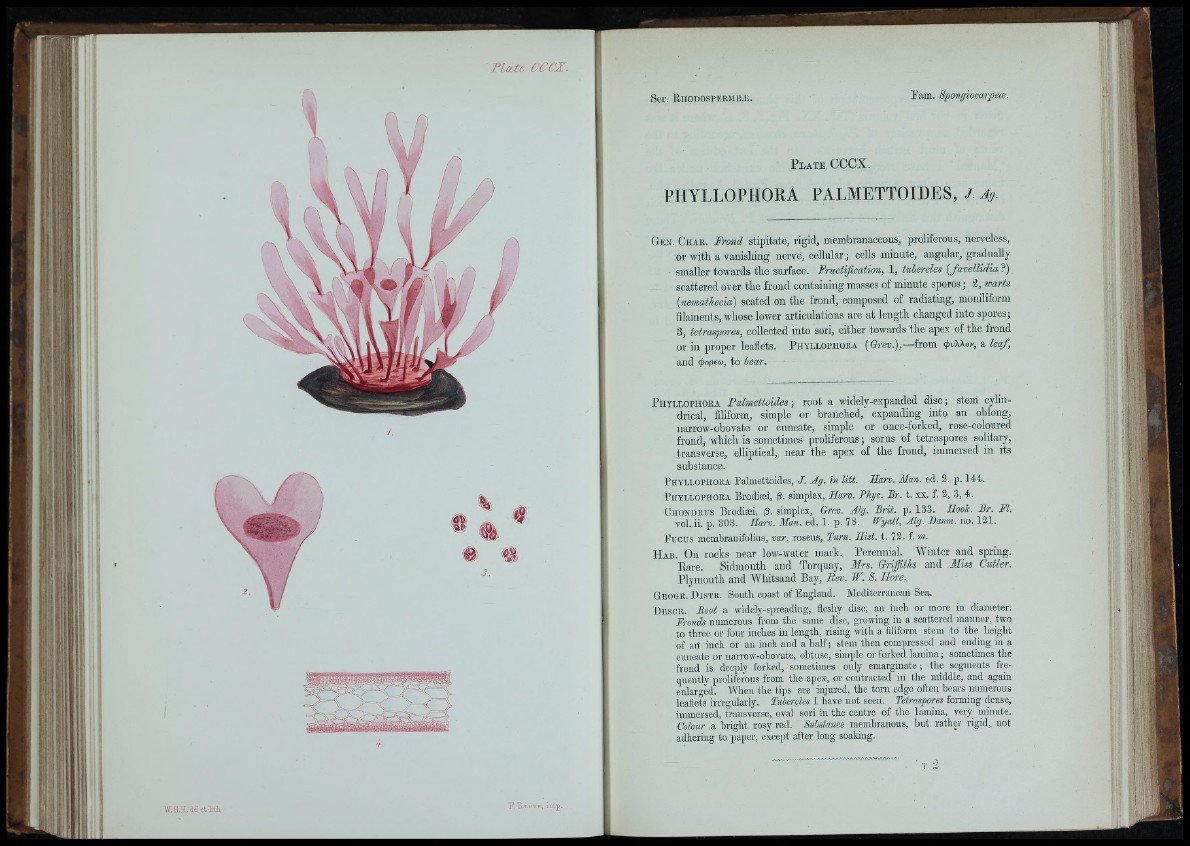
T la tf (.TCI.
P l a t e CCCX.
PHYLLOPHOEA PALMETTOIDES, /. Ag.
y
/
I
3.
G e n . C h a e . Frond s tip ita te , rig id , membranaceous, proliferous, nerveless,
o r w ith a v an ish in g ne rv e , cellular ; cells m in u te , an g u la r, gradually
smaller tow a rd s th e surface. Fructijication, 1, tnhercles (fa v e llid ia ?)
s c a tte re d over th e fro n d co n ta in in g masses of m in u te spores ; 3 , warts
(nematliecia) seated o n th e fro n d , composed of ra d ia tin g , moniliform
filaments, whose lower a rticu la tio n s are a t le n g th chan g ed in to spores;
3, tetraspores, collected in to sori, e ith e r towards th e apex of th e frond
or in p ro p e r leaflets. P h y l l o p h o e a (Grew.),—from fivWov, a leaf,
a n d 4>ope<ù, to bear.
P h yllophoea Palmettoides; root a widely-expanded disc; stem cylindrical,
filiform, simple or branched, expanding into an oblong,
narrow-obovate or cuneate, simple or once-forked, rose-coloured
frond, which is sometimes proliferous ; sorus of tetraspores solitary,
transverse, elliptical, near the apex of the frond, immersed in its
substance.
P h y l l o p h o e a Palmettoides, J. Ag. in litt. Harv. Man. ed. 3. p. 144.
P h y l l o p h o e a Brodiæi, ¡3. simplex, Harv. Phyc. Br. t. xx. f. 3, 8, 4.
C h o n d e u s Brodiæi, j3. simplex, Orev. Alg. Brit. p. 133. Hooh. Br. FI.
vol. ii. p. 303. iia re . ed. 1. p. 78. Wyatt, Alg. Banm. no. 121.
PuCTls membranifolius, var. roseus, Turn. Hist. t. 73. f. m.
H a b . On rocks near low-water mark. Perennial. Winter and spring.
Pare. Sidmouth and Torquay, Mrs. Griffiths and Miss Cutler.
Plymouth and Whitsand Bay, Piev. W. S. Hore.
G e o g e . D i s t e . South coast of England. Mediterranean Sea.
Desce. Root a widely-spreading, fleshy disc, an inch or more in diameter.
Fronds numerous from the same disc, growing in a scattered manner, two
to three or four inches in length, rising with a filiform stem to the height
of an inch or an inch and a half; stem then compressed and ending in a
cuneate or iiarrow-ohovate, obtuse, simple or forked lamina ; sometimes the
frond is deeply forked, sometimes only emarginate; the segments frequently
proliferous from the apex, or contracted in the middle, and again
enlarged. When the tips are injured, the torn edge often bears numerous
leaflets irregularly. Tubercles I have not seen. Tetraspores forming dense,
immersed, transverse, oval sori in the centre of the lamina, very minute.
Colour a bright rosy red. Substance membranous, but rather rigid, not
adhering to paper, except after long soaking.